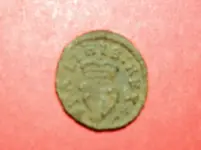Iron Patch said:
{Sentinel} said:
Iron Patch said:
{Sentinel} said:
robfinds said:
{Sentinel} said:
CRUSADER said:
Lennox type 5 - I wish I had a clue what your on about, but both your posts have made me dig out my bag of farthings to look more closely.

Your lucky to get that rare combination of condition with rarity

Awesome Find Rob. Question: What is more rare, the Richmond or the early Maltravers Royal Farthing?
To be honest Sentinel at this point I don't know, I will have a look.
It doesn't matter honestly, its the historical significance that I value anyway....no need to have to go a lookin...just thought you might know of the top of your head

You're right, because even the best of these in dug condition aren't worth a whole lot. And the common ones, well only a few dollars. Without context your coin would definitely not be a banner find.
Yep, I think we know that the coin isn't monetarily worth much (its just a piece of thin brass), however historically, here in the colonies, its rich. Only a very few found between here and Jamestown...You'd probably have a better chance of winning the lottery than finding one of these in the U.S.
Not sure why being brass and thin has anything to do with value.... and is actually the perfect description for my most valuable coin find

You're absolutely right with the lottery statement for the vast majority of us that don't have sites dating to the 1600s. But for those that do, the chances would be quite reasonable considering it's a common coin of the period. I'm not sure how many unique type finds turn up in your area but I know Ironhorse and I have many finds that aren't considered rare (as in valuable), but we have never seen someone else dig one here, or post one, so in that sense the winning the lottery thing could probably be applied to them as well. It's actually very interesting how rarity and context play into making a find what it is.
Not sure why being brass and thin has anything to do with value.
What I mean by the above is that there's no real intrinsic value in a thin little piece of copper or brass whereas if it
were,say, gold, than there would be some actual intrinsic value in the material itself.
As for it being a common coin of the period, yes you're right, over in England, however in the 1630s in America,
there were only a couple little settlements at Jamestown, VA and the Mass. Bay Colonies. And these particular coins
were only used for a very short time at Jamestown before gold and silver coin became available. Therefore, I don't
believe you would find this farthing at many other 1600s sites except for right in this general area where I live.







 You're absolutely right with the lottery statement for the vast majority of us that don't have sites dating to the 1600s. But for those that do, the chances would be quite reasonable considering it's a common coin of the period. I'm not sure how many unique type finds turn up in your area but I know Ironhorse and I have many finds that aren't considered rare (as in valuable), but we have never seen someone else dig one here, or post one, so in that sense the winning the lottery thing could probably be applied to them as well. It's actually very interesting how rarity and context play into making a find what it is.
You're absolutely right with the lottery statement for the vast majority of us that don't have sites dating to the 1600s. But for those that do, the chances would be quite reasonable considering it's a common coin of the period. I'm not sure how many unique type finds turn up in your area but I know Ironhorse and I have many finds that aren't considered rare (as in valuable), but we have never seen someone else dig one here, or post one, so in that sense the winning the lottery thing could probably be applied to them as well. It's actually very interesting how rarity and context play into making a find what it is.


